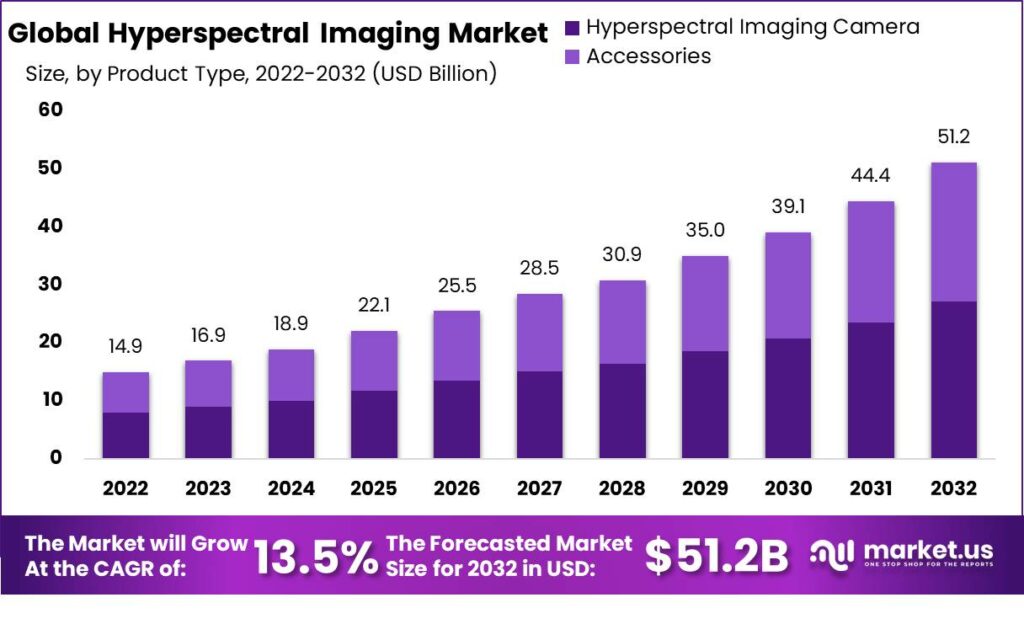According to a report by Market.us, In 2022, the Global Hyperspectral Imaging Market was valued at USD 14.9 Billion and it is projected to expand to USD 51.2 Billion by 2032; Compound Annual Growth Rate (CAGR) of 13.5% during this period. The growth in this market can be attributed to increasing demands for remote sensing in agriculture, defense and commercial applications. The report covers hyperspectral imaging remote sensing systems and the market is segmented by Product Type (Hyperspectral Imaging Camera, Accessories), By Technology (Push Broom, Snapshot, and Others), By Application (Medical Diagnostics, Remote Sensing, Military Surveillance, Machine vision, and Other Applications), By Spectral Range (Visible Hyperspectral Imaging, Visible Near-Infrared (VNIR) Hyperspectral Imaging, Short-Wave Infrared (SWIR) Hyperspectral Imaging, Mid-Wave Infrared and Long-Wave Infrared Hyperspectral Imaging, and Other Spectral Ranges), By End-User(Healthcare, Food And Agriculture, Defence, Mining And Metrology, and Other End-Users).
Get a glance at the market contribution of the segments, Request a FREE Sample
Hyperspectral imaging (HSI) is an optical remote sensing technique which measures the electromagnetic spectrum reflected or emitted from objects, creating a signature which allows identification and classification. HSI systems take hundreds or even thousands of images at various wavelengths at one scene at the same time to build up a data cube which can then be analysed further to reveal information otherwise inaccessible by humans.

Some of the key takeaways for the hyperspectral imaging market include:
- The major types of hyperspectral imaging systems are pushbroom and snapshot.
- The major drivers of the hyperspectral imaging market include the increasing demand for precision agriculture, the growing need for national security and environmental monitoring, and the rising demand for non-invasive medical diagnostics.
- The major restraints of the hyperspectral imaging market include the high cost of HSI systems and the complexity of HSI image processing.
- The major challenges facing the hyperspectral imaging market include the lack of trained HSI specialists and the need for standardization in HSI data collection and analysis.
- The major opportunities in the hyperspectral imaging market include the development of new and innovative applications for HSI, the reduction in the cost of HSI systems, and the increasing availability of HSI data.
- The major applications of hyperspectral imaging include agriculture, defense, environmental monitoring, food safety, and medical diagnostics.
- The major players in the hyperspectral imaging market include ClydeHSI, Cubert, Perspective Vision GmbH, Headwall Photonics Inc., Specim Spectral Imaging Ltd., Imec, Norsk Elektro Optikk A/S, Resonon Inc, Surface Optics Corp, Ximea and Other Key Players
Get deeper insights into the market size, current market scenario, future growth opportunities, major growth driving factors, the latest trends, and much more. Buy the full report here
What are some challenges in hyperspectral imaging?
- Data Acquisition: Capturing hyperspectral images requires special equipment and is time consuming, since this involves scanning an object or scene at different wavelengths resulting in large volumes of data that need to be processed and analyzed before being stored for future reference.
- Data Processing: Hyperspectral data is multidimensional, necessitating advanced algorithms for processing and analysis. Extracting useful insights from it requires computational effort as well as expert software and knowledge for successful interpretation.
- Calibration: Proper calibration of hyperspectral sensors is crucial to producing reliable measurements that adhere to industry standards. Calibration means compensating for sensor noise, nonuniformity and other variables which might skew data accuracy and compromise its integrity.
- Spectral Unmixing: Hyperspectral images often feature mixed pixels composed of contributions from various materials or substances. Decomposing mixed pixels back into individual spectra may prove challenging due to factors like noise, illumination variations and overlapped signature spectrographs; unmixing is therefore required in order to deconstruct them properly.
- Data Interpretation: Understanding hyperspectral data requires expert spectral analysis knowledge. Deciphering materials’ signature spectra can often be complex when dealing with subtle variations or overlapped signatures.
- Cost: Hyperspectral imaging systems can be expensive, making them unavailable to certain applications or industries. Acquiring, operating and maintaining hyperspectral equipment may pose as a barrier for some users.
Market Segments
By Product Type
- Hyperspectral Camera
- Accessories
By Technology
- Push-broom
- Snapshot
- Other Technologies
By Application
- Medical Diagnostics
- Military Surveillance
- Remote Sensing
- Machine Vision
- Other Applications
By Spectral Range
- Visible Hyperspectral Imaging
- Visible Near-Infrared (VNIR) Hyperspectral Imaging
- Short-Wave Infrared (SWIR) Hyperspectral Imaging
- Mid-Wave Infrared and Long-Wave Infrared Hyperspectral Imaging
- Other Spectral Ranges
By End-User
- Healthcare
- Food and Agriculture
- Defense
- Mining and Metrology
- Other End-Users
Top Key Players
The following are some of the major players in the industry:
- ClydeHSI
- Cubert
- Perspective Vision GmbH
- Headwall Photonics Inc.
- Specim Spectral Imaging Ltd.
- Imec
- Norsk Elektro Optikk A/S
- Resonon Inc
- Surface Optics Corp
- Ximea
- Other Key Players